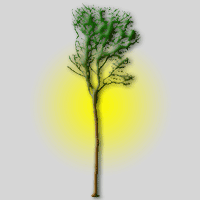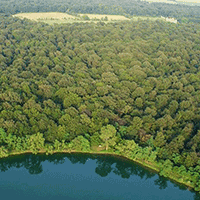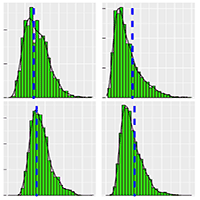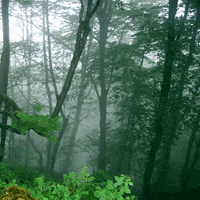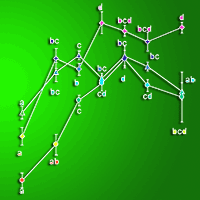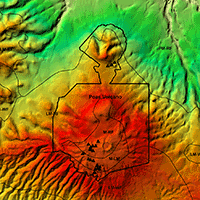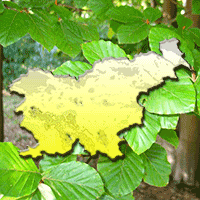Sustainable forest management practices and the increased interest of plantation forestry in species mixtures require an understanding of individual-tree growth in complex and diverse forests. Individual-tree growth has been found to be affected by factors such as species identity and size of the target tree as well as of neighboring trees, neighbor density and abiotic factors. However, most of these studies have been conducted in plantations or mixed forests with a very limited number of species. We conducted our study in a subtropical forest in China, which was very species rich and highly heterogeneous with regard to topography (slope inclination and aspect, elevation) and successional status. Prior to our study the forest was subjected to an exceptional snow break event. We asked whether individual-tree basal area increment (BAI) over three growing seasons following the snow break event was related to local biotic and abiotic conditions. We hypothesized that individual-tree BAI is negatively affected by local neighborhood competition, positively affected by local neighborhood diversity, negatively related to slope inclination, and positively related to aspect to south. Individual-tree BAI of four different species was mainly affected by tree size, local neighborhood competition and species identity. Contrary to our expectations, we did not observe significant effects of local neighborhood functional diversity and abiotic conditions. However, we did find a negative effect of plot functional diversity on BAI. This finding may be explained by a negative correlation of plot functional diversity and snow break damage, which was observed in mid- and late-successional stages. The disturbance event did considerably change the competitive local neighborhood interactions by reducing competition, which increased the BAI of target trees in more disturbed/more diverse plots.
Keywords
, , , ,
Citation
Lang AC, Härdtle W, Bruelheide H, von Oheimb G (2014). Local neighborhood competition following an extraordinary snow break event: implications for tree-individual growth. iForest 7: 19-24. - doi: 10.3832/ifor1033-007
Academic Editor
Emanuele Lingua
Paper history
Received: May 03, 2013
Accepted: Jul 07, 2013
First online: Oct 14, 2013
Publication Date: Feb 03, 2014
Publication Time: 3.30 months
© SISEF - The Italian Society of Silviculture and Forest Ecology 2014
Open Access
This article is distributed under the terms of the Creative Commons Attribution-Non Commercial 4.0 International (https://creativecommons.org/licenses/by-nc/4.0/), which permits unrestricted use, distribution, and reproduction in any medium, provided you give appropriate credit to the original author(s) and the source, provide a link to the Creative Commons license, and indicate if changes were made.

Breakdown by View Type
(Waiting for server response...)
Article Usage
Total Article Views: 57976
(from publication date up to now)
Breakdown by View Type
HTML Page Views: 49505
Abstract Page Views: 2907
PDF Downloads: 3978
Citation/Reference Downloads: 34
XML Downloads: 1552
Web Metrics
Days since publication: 4448
Overall contacts: 57976
Avg. contacts per week: 91.24
Article Citations
Article citations are based on data periodically collected from the Clarivate Web of Science web site
(last update: Mar 2025)
Total number of cites (since 2014): 1
Average cites per year: 0.08
Publication Metrics
by Dimensions ©
Articles citing this article
List of the papers citing this article based on CrossRef Cited-by.
(1)
Aubrey DP, Coleman MD, Coyle DR (2007)Ice damage in Loblolly Pine: understanding the factors that influence susceptibility. Forest Science 53: 580-589.
Online |
Gscholar
(2)
Bauhus J, Puettmann K, Messier C (2009)Silviculture for old-growth attributes. Forest Ecology and Management 258 (4): 525-537.
CrossRef |
Gscholar
(3)
Biging GS, Dobbertin M (1992)A comparison of distance-dependent competition measures for height and basal area growth of individual conifer trees. Forest Science 38: 695-720.
Online |
Gscholar
(4)
Boivin F, Paquette A, Papaik MJ, Thiffault N, Messier C (2010)Do position and species identitiy of neighbours matter in 8-15-year-old post harvest mesic stands in the boreal mixedwood? Forest Ecology and Management 260: 1124-1131.
CrossRef |
Gscholar
(5)
Botta-Dukat Z (2005)Rao’s quadratic entropy as a measure of functional diversity based on multiple traits. Journal of Vegetation Science 16. 533-540.
CrossRef |
Gscholar
(6)
Bowman DMJS, Brienen RJW, Gloor E, Phillips OL, Prior LD (2013)Detecting trends in tree growth: not so simple. Trends in Plant Science 18: 11-17.
CrossRef |
Gscholar
(7)
Bragg DC, Shelton MG, Zeide B (2003)Impacts and management implications of ice storms on forests in the southern United States. Forest Ecology and Management 186: 99-123.
CrossRef |
Gscholar
(8)
Bruelheide H, Böhnke M, Both S, Fang T, Assmann T, Baruffol M, Bauhus J, Buscot F, Chen X-Y, Ding B-Y, Durka W, Erfmeier A, Fischer M, Geißler C, Guo D, Guo L-D, Härdtle W, He J-S, Hector A, Kröber W, Kühn P, Lang AC, Nadrowski K, Pei K, Scherer-Lorenzen M, Shi X, Scholten T, Schuldt A, Trogisch S, von Oheimb G, Welk E, Wirth C, Wu Y-T, Yang X, Zeng X, Zhang S, Zhou H, Ma K, Schmid B (2011)Community assembly during secondary forest succession in a Chinese subtropical forest. Ecological Monographs 81: 25-41.
CrossRef |
Gscholar
(9)
Canham CD, LePage PT, Coates KD (2004)A neighborhood analysis of canopy tree competition: effects of shading versus crowding. Canadian Journal of Forest Research 34: 778-787.
CrossRef |
Gscholar
(10)
Cao S, Sun G, Zhang Z, Chen L, Feng Q, Fu B, McNulty S, Shankman D, Tang J, Wang Y, Wei X (2011)Greening China naturally. Ambio 40: 828-831.
CrossRef |
Gscholar
(11)
Cao Y, Ouyang ZY, Zheng H, Huang ZG, Wang XK, Miao H (2008)Effects of forest plantations on rainfall redistribution and erosion in the red soil region of southern China. Land Degradation and Development 19: 321-330.
CrossRef |
Gscholar
(12)
Castagneri D, Vacchiano G, Lingua E, Motta R (2008)Analysis of intraspecific competition in two subalpine Norway spruce (
Picea abies (L.) Karst.) stands in Paneveggio (Trento, Italy). Forest Ecology and Management 255: 651-659.
CrossRef |
Gscholar
(13)
Cavard X, Bergeron Y, Chen HYH, Paré D, Laganière J, Brassard B (2011)Competition and facilitation between tree species change with stand development. Oikos 120: 1683-1695.
CrossRef |
Gscholar
(14)
Crawley MJ (2007)The R Book. John Wiley & Sons Ltd., Chichester, UK, pp. 877.
Gscholar
(15)
Chen ZH, Wang BS, Zhang HD (1999)Growth of the trees and saplings in the lower subtropical evergreen broad-leaved forest in Heishiding, Guangdong Province. Acta Phytoecologica Sinica 23: 441-450.
Gscholar
(16)
Crescente-Campo F, Dieguez-Aranda U, Rodriguez-Soalleiro R (2012)Resource communication. Individual-tree growth model for radiata pine plantations in northwestern Spain. Forest Systems 3: 538-542.
CrossRef |
Gscholar
(17)
D’Amato AW, Puettmann KJ (2004)The relative dominance hypothesis explains interactions dynamics in mixed species
Alnus rubra /
Pseudotsuga menziesii forests. Journal of Ecology 92: 450-463.
CrossRef |
Gscholar
(18)
Forrester DI, Bauhus J, Cowie AL, Vanclay JK (2006)Mixed-species plantations of Eucalyptus with nitrogen-fixing trees: a review. Forest Ecology and Management 233: 211-230.
CrossRef |
Gscholar
(19)
Forrester DI, Vanclay JK, Forrester RI (2011)The balance between facilitation and competition in mixtures of Eucalyptus and Acacia changes as stands develop. Oecologia 166: 265-272.
CrossRef |
Gscholar
(20)
Hartmann H, Messier C (2011)Interannual variation in competitive interactions from natural and anthropogenic disturbances in a temperate forest tree species: Implications for ecological interpretation. Forest Ecology and Management 261: 1936-1944.
CrossRef |
Gscholar
(21)
Hothorn T, Bretz F, Westfall P (2008)Simultaneous inference in general parametric models. Biometrical Journal 50: 346-363.
CrossRef |
Gscholar
(22)
Hu Z, Yu M (2008)Study on successions sequence of evergreen broad-leaved forest in Gutian mountain of Zhejiang, eastern China: species diversity. Frontiers of Biology in China 3 (1): 45-49.
CrossRef |
Gscholar
(23)
Ishii R, Higashi M (1997)Tree coexistence on a slope: an adaptive significance of trunk inclination. Proceedings of the Royal Society of London Series B - Biological Sciences 264: 133-139.
CrossRef |
Gscholar
(24)
Kelty MJ (1992)Comparative productivity of monocultures and mixed-species stands. In: “The ecology and silvicultures of mixed-species forests” (Kelty MJ ed). Kluwer Academic Publishers, Dordrecht, Germany, pp. 125-141.
Gscholar
(25)
Kelty MJ (2006)The role of species mixtures in plantation forestry. Forest Ecology and Management 233: 195-204.
CrossRef |
Gscholar
(26)
Kröber W, Böhnke M, Welk E, Wirth C, Bruelheide H (2012)Leaf trait-environment relationships in a subtropical broadleaved forest in South-East China. PLoS ONE 7 (4): e35742.
CrossRef |
Gscholar
(27)
Lang AC, Härdtle W, Bruelheide H, Geißler C, Nadrowski K, Schuldt A, Yu M, von Oheimb G (2010)Tree morphology responds to neighbourhood competition and slope in species-rich forests of subtropical China. Forest Ecology and Management 260: 1708-1715.
CrossRef |
Gscholar
(28)
Lang AC, Härdtle W, Baruffol M, Böhnke M, Bruelheide H, Schmid B, Von Wehrden H, Von Oheimb G (2012a)Mechanisms promoting tree species coexistence: experimental evidence with saplings from subtropical forest ecosystems of China. Journal of Vegetation Science 23: 837-846.
CrossRef |
Gscholar
(29)
Lang AC, Härdtle W, Bruelheide H, Kröber W, Schröter M, von Wehrden H, Von Oheimb G (2012b)Horizontal, but not vertical canopy structure is related to stand functional diversity in a subtropical slope forest. Ecological Research 27: 181-189.
CrossRef |
Gscholar
(30)
Man XX, Mi XC, Ma KP (2011)Effects of an ice storm on community structure of an evergreen broadleaved forest in Gutianshan National Nature Reserve, Zhejiang Province. Biodiversity Science 19: 197-205.
CrossRef |
Gscholar
(31)
Massey FP, Massey K, Press MC, Hartley SE (2006)Neighbourhood composition determines growth, architecture and herbivory in tropical rain forest tree seedlings. Journal of Ecology 94: 646-655.
CrossRef |
Gscholar
(32)
Paquette A, Messier C (2011)The effect of biodiversity on tree productivity: from temperate to boreal forests. Global Ecology and Biogeography 20: 170-180.
CrossRef |
Gscholar
(33)
Pinheiro J, Bates D, DebRoy S, Sarkar D, R Core Team (2010)NLME: linear and nonlinear mixed effects models. R package version 3.1-97.
Online |
Gscholar
(34)
Pretzsch H (2009)Forest dynamics, growth and yield: from measurement to model. Springer- Verlag, Berlin, Heidelberg, Germany, pp. 663.
Gscholar
(35)
Pretzsch H, Schütze G (2009)Transgressive overyielding in mixed compared with pure stands of Norway spruce and European beech in Central Europe: evidence on stand level and explanation on individual tree level. European Journal of Forest Research 128: 183-204.
CrossRef |
Gscholar
(36)
Rao C (1982)Diversity and dissimilarity coefficients: a unified approach. Theoretical Population Biology 21: 24-43.
CrossRef |
Gscholar
(37)
Ruiz-Jaen MC, Potvin C (2010)Tree diversity explains variation in ecosystem function in a neotropical forest in Panama. Biotropica 42: 638-646.
CrossRef |
Gscholar
(38)
Schwinning S, Weiner J (1998)Mechanisms determining the degree of size asymmetry in competition among plants. Oecologia 113: 447-455.
CrossRef |
Gscholar
(39)
Shao QQ, Huang L, Liu J, Kuang W, Li J (2011)Analysis of forest damage caused by the snow and ice chaos along a transect across southern China in spring 2008. Journal of Geographical Sciences 21: 219-234.
CrossRef |
Gscholar
(40)
Smolnik M, Hessl A, Colbert JJ (2006)Species-specific effects of a 1994 ice storm on radial tree growth in Delware. Journal of the Torrey Botanical Society 133: 577-584
CrossRef |
Gscholar
(41)
Stoll P, Newbery DM (2005)Evidence of species-specific neighborhood effects in the dipterocarpaceae of a Bornean rain forest. Ecology 86: 3048-3062.
CrossRef |
Gscholar
(42)
Stoll P, Weiner J, Schmid B (1994)Growth variation in a naturally established popultation of
Pinus sylvestris. Ecology 75: 660-670.
CrossRef |
Gscholar
(43)
Umeki K (1995)Modeling the relationship between the asymmetry in crown display and local environment. Ecological Modelling 82: 11-20.
CrossRef |
Gscholar
(44)
Vila M, Vayreda J, Comas L, Josep Ibanez J, Mata T, Obon B (2007)Species richness and wood production: a positive association in Mediterranean forests. Ecology Letters 10: 241-250.
CrossRef |
Gscholar
(45)
Von Oheimb G, Lang AC, Bruelheide H, Forrester DI, Wäsche I, Yu M, Härdtle W (2011)Individual-tree radial growth in a subtropical broad-leaved forest: The role of local neighbourhood competition. Forest Ecology and Management 261: 499-507.
CrossRef |
Gscholar
(46)
Warren RJ (2010)An experimental test of well-described vegetation patterns across slope aspects using woodland herb transplants and manipulated abiotic drivers. New Phytologist 185: 1038-1049.
CrossRef |
Gscholar
(47)
Xing P, Zhang QB, Baker PJ (2012)Age and radial growth pattern of four tree species in a subtropical forest of China. Trees - Structure and Functions 26: 283-290.
CrossRef |
Gscholar
(48)
Yang X, Bauhus J, Both S, Fang T, Härdtle W, Kröber W, Ma K, Nadrowski K, Pei K, Scherer-Lorenzen M, Scholten T, Seidler G, Schmid B, Oheimb G, Bruelheide H (2013)Establishment success in a forest biodiversity and ecosystem functioning experiment in subtropical China (BEF-China). European Journal of Forest Research 132 (4): 593-606.
CrossRef |
Gscholar
(49)
Yu M-J, Hu Z-H, Ding B-Y, Fang T (2001)Forest vegetation types in Gutianshan Natural Reserve in Zhejiang. Journal of Zhejiang University (Agriculture and Life Science) 27: 375-380.
Gscholar
(50)
Zhang Y, Song C (2006)Impacts of afforestation, deforestation, and reforestation on forest cover in China from 1949 to 2003. Journal of Forestry October/November, 383-387.
Online |
Gscholar
(51)
Zhao D, Borders B, Wilson M (2004)Individual- tree diameter growth and mortality models for bottomland mixed-species hardwood stands in the lower Mississippi alluvial valley. Forest Ecology and Management 199: 307-322.
CrossRef |
Gscholar
(52)
Zhou B, Gu L, Ding Y, Shao L, Wu Z, Yang X, Li C, Li Z, Wang X, Cao Y, Zeng B, Yu M, Wang M, Wang S, Sun H, Duan A, An Y, Wang X, Kong W (2011)The great 2008 Chinese ice storm. Its socio-economic-ecological impact and sustainability lessons learned. Bulletin of the American Meteorological Society 92: 47-60.
CrossRef |
Gscholar


